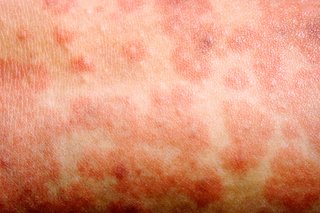SymptomsMeasles
Measles starts with cold-like symptoms that develop about 10 days after becoming infected. This is followed a few days later by the measles rash.
For most people, the illness lasts around 7 to 10 days.
Initial symptoms
The initial symptoms of measles can include:
- a runny or blocked nose
- sneezing
- watery eyes
- swollen eyelids
- sore, red eyes that may be sensitive to light
- a high temperature (fever), which may reach around 40C (104F)
- small greyish-white spots in the mouth
- aches and pains
- a cough
- loss of appetite
- tiredness, irritability and a general lack of energy
Spots in the mouth

A day or two before the rash appears, many people with measles develop small greyish-white spots in their mouth.
Not everyone with measles has these spots, but if someone has them in addition to the other symptoms listed above or a rash, it's highly likely they have the condition.
The spots will usually last for a few days.
The measles rash


The measles rash appears around 2 to 4 days after the initial symptoms and normally fades after about a week.
You'll usually feel most ill on the first or second day after the rash develops.
The rash:
- is made up of small red-brown, flat or slightly raised spots that may join together into larger blotchy patches
- usually first appears on the head or neck before spreading outwards to the rest of the body
- is slightly itchy for some people
- can look similar to other childhood conditions, such as slapped cheek syndrome, roseola or rubella
- is unlikely to be caused by measles if the person has been fully vaccinated (had 2 doses of the MMR vaccine) or had measles before
When to seek medical advice
Contact your GP as soon as possible if you suspect that you or your child has measles, even if you're not completely sure.
It's best to phone before your visit, as your GP surgery may need to make arrangements to reduce the risk of spreading the infection to others.
You should also see your GP if you have been in close contact with someone who has measles and haven't been fully vaccinated or haven't had the infection before, even if you don't have any symptoms yet.